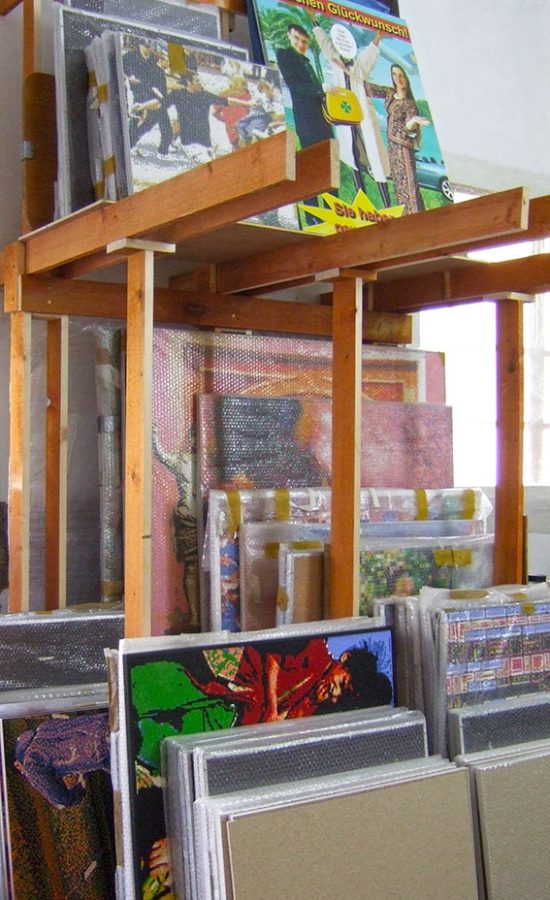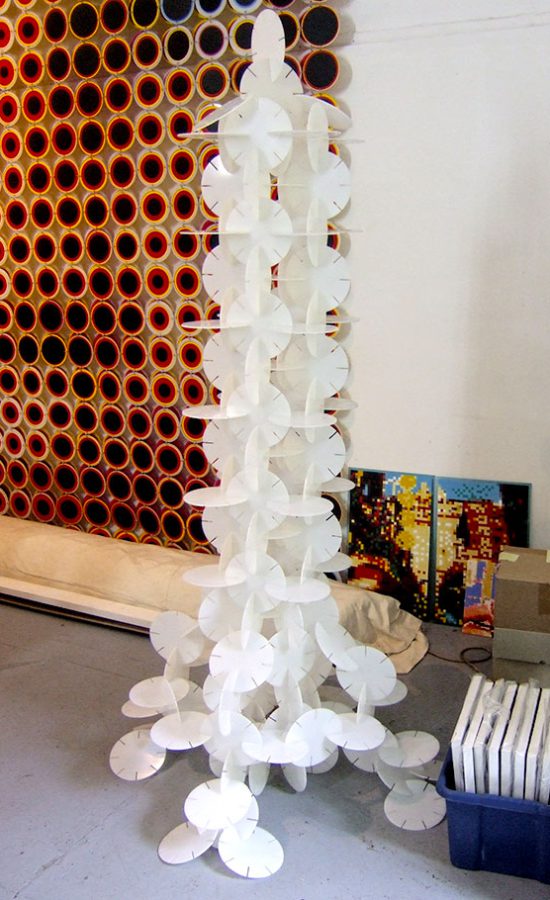Seit 1994 arbeiten „Friederike & Uwe“ in München als Künstlerduo zusammen.
Nach einigen Jahren der Beschäftigung mit Kitsch-Art in allen Erscheinungsformen (Fotografie, Objekt, Video, Performance etc. – siehe auch das „Friederike & Uwe“ Buch) haben sie die Mosaiktechnik in Verbindung mit moderner Computertechnologie für sich als Bildmedium entdeckt.
Schwerpunkt ihrer gemeinsamen Arbeit sind seit 1998/99 Mosaiken aus dem Spielzeug-Puzzle „ministeck“ und diversen anderen Kunststoffmaterialien, wie zum Beispiel Kunststoff-Verschlusskappen für Getränkeflaschen, Plastikstäbchen und Kunststoff-Plotterfolien.
Dabei erzeugen die beiden Künstler am Computer mit Hilfe von digitalisiertem Bildmaterial und entsprechenden Bildbearbeitungsprogrammen exakte Entwürfe für ihre anschließend in filigraner Handarbeit analog umgesetzten Kunststoffmosaike.
Es geht ihnen dabei nicht primär um die bloße Umsetzung von Bildern in Mosaike, sondern vor allem um die Erforschung der Pixel-Strukturen unter verschiedensten Bedingungen sowie die inhaltliche Auseinandersetzung mit der Technik und dem Material Kunststoff.
Fragen der Farbgestaltung und der Komposition spielen dabei natürlich ebenso wie in der Malerei eine große Rolle.
Motivisch behandeln sie aktuell Themenkreise zwischen Idyll und Gewalt („Tulpen und Terror“ textete die SZ): diffuse allgemeine bzw. gemeinsame Erinnerungen ihrer Generation, mehr oder weniger bedeutsame Belanglosigkeiten und Momente des Lebens, Krieg als Unterhaltung, Blut als ästhetisches „Computerspiel-Still“.
Es geht ihnen dabei um medial vermittelte Realitäten, um das Verhältnis von Inhalt und Oberfläche, um den Bezug von Kunst, Künstlichkeit und Leben. Die stellenweise Ununterscheidbarkeit, der fließende Übergang von Virtualität und Realität ist dabei thematisch von großem Interesse – das Leben als Simulation.
Dabei versuchen sie, nie den Humor zu verlieren, einerseits um ironische (Selbst-)Distanz zu wahren, andererseits sozusagen als letzte Waffe im Kampf gegen die Absurdität des Daseins, gegen Resignation und Hilflosigkeit.
Das von den beiden nahezu ausschließlich verwendete Material Plastik steht hierbei als Ausdruck ständiger Verfügbarkeit, für Überfluss, Unverrottbarkeit und Uneitelkeit, aber auch als Symbol für geronnene Künstlichkeit, für die uns alle längst umgebende bunte Plastikwelt.
„Die Umwelt von Friederike & Uwe besteht aus Plastik in sämtlichen Formen und Aggregatszuständen, sie selbst in „Original-Verpackung“ eingeschlossen. So nehmen sie vorweg, was möglicherweise nicht nur in Sicht kommt, sondern schon bald da sein wird: den Plastikmenschen.“ (Aus: Applaus 7/8 2001)
Der Pixel, Grundelement der digitalen Optik, erstarrt in Kunststoff, wird so für „Friederike & Uwe“ zum „Mosaikstein“ der Epoche, der thematisch wie stilistisch vielfältig eingesetzt werden kann.
Since 1994, ”Friederike & Uwe” have been working as an artists‘ couple in Munich.
After a few years of concentrating on Kitsch-Art in all its facets like photography, objects, video, performance (see the Friederike & Uwe book), F&U discovered the technique of mosaics in combination with modern computer technology as a picture medium.
Since 1998/99, the artists’ couple has concentrated their common work on mosaics made of the toy puzzle “ministeck” and various other plastic materials like plastic lids for drinking bottles, plastic sticks and plotter film out of plastic.
The artists develop their work on the computer with the help of digitalised picture material and image editing programmes. This way F&U produce exact designs for their handcrafted delicate analogue mosaics.
Their aim is not just to turn digitalised templates into haptic mosaics, but first of all to explore the pixel structures under the most various circumstances and to analyse modern technology as well as the plastic material.
The question of colour design and that of colour composition play as big a role as in painting.
Their motives circle between idyll and violence “Tulpen und Terror” (“Tulips and Terror”) was the headline in Sueddeutsche Zeitung): Diffuse general respectively common memories of their generation, more or less important insignificances and moments of life, war as entertainment, blood as an aesthetic “Computer-Game Still Life”.
F&U want to show medial realities, the relation between content and surface, the relation between art, artificiality and life. At times there is indistinguishability, fluent transition between virtuality and reality, which is of great interest to the artists – life as a simulation.
In their works, F&U never lose their humour to keep an ironic self-distance on the one hand, and on the other hand to use it as a weapon in the fight against absurdity of existence, against resignation and helplessness.
The couple uses almost exclusively plastic material which expresses permanent availability, abundance, permanence, lack of vanity, but also symbolises coagulated artificiality for the plastic world surrounding all of us.
“The F&U environment consists of all forms and aggregate conditions of plastic, including the couple itself in ‘original packaging’. Thus, they anticipate what will not only be in sight, but will soon be there: Plastic Man.” (from: Applaus 7/8 2001)
For F&U, the pixel as the basic element of digital optics, frozen in plastic, turns into a tessera of our era which can be used in a large topical and stylistic variety.


